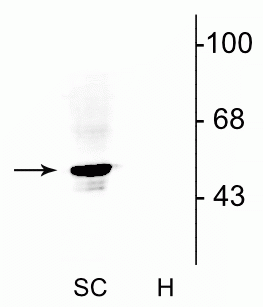Anti-Glycine Receptor Antibody
Our Anti-Glycine Receptor rabbit polyclonal primary antibody from PhosphoSolutions is produced in-ho
- SPECIFICATION
- CITATIONS
- PROTOCOLS
- BACKGROUND

Application
| WB |
|---|---|
| Primary Accession | P07727 |
| Reactivity | Bovine |
| Host | Rabbit |
| Clonality | Polyclonal |
| Isotype | IgG |
| Calculated MW | 52617 Da |
| Gene ID | 25674 |
|---|---|
| Other Names | GLRA1 antibody, GLRA1_HUMAN antibody, Glycine receptor 48 kDa subunit antibody, lycine receptor alpha 1 antibody, Glycine receptor strychnine-binding subunit antibody, Glycine receptor subunit alpha-1 antibody, Glycine receptor, alpha 1 subunit antibody, HKPX1 antibody, STHE antibody |
| Target/Specificity | Glycine is an important inhibitory transmitter in the brainstem and spinal cord. Glycine receptors are members of the ligand-gated ion channel family (LGICs) that mediate rapid chemical neurotransmission (Schofield et al., 2003). The binding of glycine to its receptor produces a large increase in chloride conductance, which causes membrane hyperpolarization. Glycine receptors are anchored at inhibitory chemical synapses by a cytoplasmic protein, gephyrin (Fischer et al., 2000). The glycine receptor has been used to great advantage in the identification of the binding sites for alcohol on the LGIC family of proteins (Beckstead et al., 2001; Mihic et al., 1997). These receptors have also been extremely useful in studies of synaptic clustering of receptors (Craig and Lichtman, 2001). The glycine receptor may also act in concert with an NMDAR subunit to form an excitatory receptor (Chatterton et al., 2002). |
| Dilution | WB~~1:1000 |
| Format | Antigen Affinity Purified from Pooled Serum |
| Storage | Maintain refrigerated at 2-8°C for up to 6 months. For long term storage store at -20°C in small aliquots to prevent freeze-thaw cycles. |
| Precautions | Anti-Glycine Receptor Antibody is for research use only and not for use in diagnostic or therapeutic procedures. |
| Shipping | Blue Ice |

Thousands of laboratories across the world have published research that depended on the performance of antibodies from Abcepta to advance their research. Check out links to articles that cite our products in major peer-reviewed journals, organized by research category.
info@abcepta.com, and receive a free "I Love Antibodies" mug.
Provided below are standard protocols that you may find useful for product applications.
Background
Glycine is an important inhibitory transmitter in the brainstem and spinal cord. Glycine receptors are members of the ligand-gated ion channel family (LGICs) that mediate rapid chemical neurotransmission (Schofield et al., 2003). The binding of glycine to its receptor produces a large increase in chloride conductance, which causes membrane hyperpolarization. Glycine receptors are anchored at inhibitory chemical synapses by a cytoplasmic protein, gephyrin (Fischer et al., 2000). The glycine receptor has been used to great advantage in the identification of the binding sites for alcohol on the LGIC family of proteins (Beckstead et al., 2001; Mihic et al., 1997). These receptors have also been extremely useful in studies of synaptic clustering of receptors (Craig and Lichtman, 2001). The glycine receptor may also act in concert with an NMDAR subunit to form an excitatory receptor (Chatterton et al., 2002).
If you have used an Abcepta product and would like to share how it has performed, please click on the "Submit Review" button and provide the requested information. Our staff will examine and post your review and contact you if needed.
If you have any additional inquiries please email technical services at tech@abcepta.com.













 Foundational characteristics of cancer include proliferation, angiogenesis, migration, evasion of apoptosis, and cellular immortality. Find key markers for these cellular processes and antibodies to detect them.
Foundational characteristics of cancer include proliferation, angiogenesis, migration, evasion of apoptosis, and cellular immortality. Find key markers for these cellular processes and antibodies to detect them. The SUMOplot™ Analysis Program predicts and scores sumoylation sites in your protein. SUMOylation is a post-translational modification involved in various cellular processes, such as nuclear-cytosolic transport, transcriptional regulation, apoptosis, protein stability, response to stress, and progression through the cell cycle.
The SUMOplot™ Analysis Program predicts and scores sumoylation sites in your protein. SUMOylation is a post-translational modification involved in various cellular processes, such as nuclear-cytosolic transport, transcriptional regulation, apoptosis, protein stability, response to stress, and progression through the cell cycle. The Autophagy Receptor Motif Plotter predicts and scores autophagy receptor binding sites in your protein. Identifying proteins connected to this pathway is critical to understanding the role of autophagy in physiological as well as pathological processes such as development, differentiation, neurodegenerative diseases, stress, infection, and cancer.
The Autophagy Receptor Motif Plotter predicts and scores autophagy receptor binding sites in your protein. Identifying proteins connected to this pathway is critical to understanding the role of autophagy in physiological as well as pathological processes such as development, differentiation, neurodegenerative diseases, stress, infection, and cancer.


